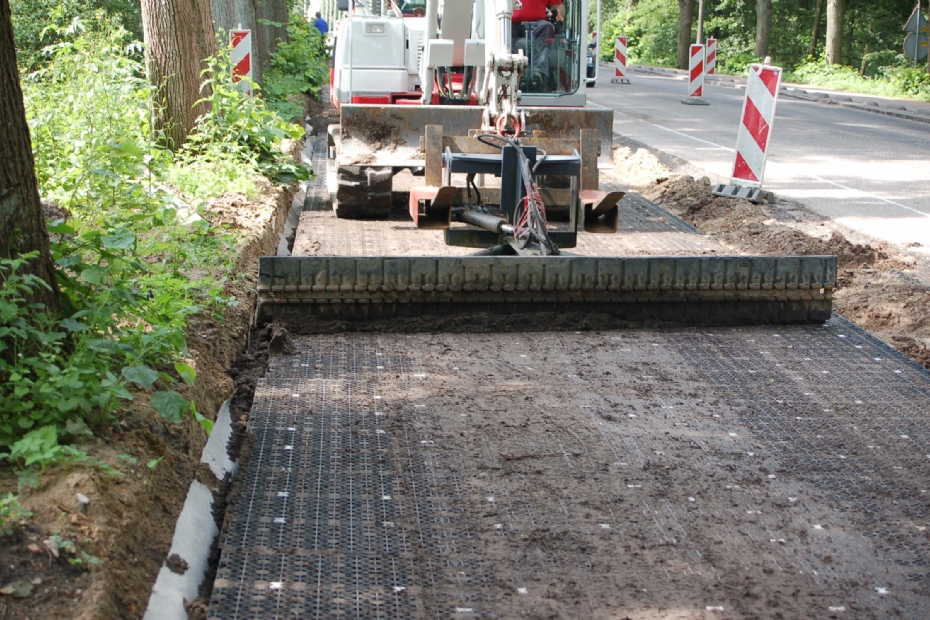Floating foundation above conflict zone protects tree roots |
|
| GARDEN AND PARK TECHNOLOGY |
|
|
|
|
| Erwin van Herwijnen,
Monday 24 February 2025 |
 |
| 153 sec |
Bike paths and trees
Who doesn't own a bicycle these days? Although nowadays, it is often an electric bike. Everyone cycles to work, sports, hobbies, or family from time to time. It's a beautiful experience, cycling through a landscape with trees. But cyclists are vulnerable. That is why the choice is often made to let cyclists ride not directly along the roadway but protected behind a row of trees. However, this does have an impact on the well-being or even the survival of the trees themselves.
| Construction of a bike path in Epe with a floating foundation |
To preserve trees, it is necessary to respect their foundation—namely, their growing site. It is often said that what a tree has above the ground, it also has below. While this is not entirely true in terms of square meters of wood or roots, the crown of a tree is balanced with its underground part. One could say that the crown reflects the well-being of the root system and that the root system is the soul of the tree. When a tree can grow under good conditions, this is usually visible in the condition of the crown. If the underground conditions are poor, it immediately becomes evident in the crown as well.
Conflict zone
What is the problem when constructing a bike path in a zone where trees derive their nutrients? Essentially, we create a conflict zone. Trees need a base that is open and permeable, while a bike path's foundation must be compacted and closed. Opposing interests, in other words. However, it is not always a problem to construct a bike path in an area where tree roots have developed. The foundation of the bike path must then be adjusted. Traditionally, a section is excavated and then rebuilt with foundation material, which happens to be the zone where the (most important) roots are located.
Floating foundation
New Urban Standard has frequently implemented a floating foundation over the root zone, on which a bike path was built. Often, this was for a different reason, but the effect was the same: the tree roots remained intact, and the growing conditions remained at least the same.
 | | Construction of the bike path in Hengelo |
|
|
In 2007, New Urban Standard constructed a bike path for the first time, though for a completely different reason. BTL Bomendienst—now idverde—had determined that no roots were present under the bike path in that location. At first glance, not a problem. However, the trees along Haaksbergseweg, lindens planted in the 1950s marking the entrance to Hengelo, were situated on an embankment. When wind speeds reached force 7, two trees toppled over due to an asymmetrical root system and excessive top weight. Nationale Bomenbank then used air compression methods, nutrient pillars, and the Permavoid Sandwich construction to fill 150 growth sites with Sandwich soil, a type of forest litter. This encouraged the roots to develop within the bike path zone. The challenge was that New Urban Standard applied 3.5 cm of crushed split on the load-distributing construction, followed by asphalt. However, the heavy weight of the material posed no issue, and even the hot asphalt had no effect on the hollow plastic foundation. To this day, the asphalt remains in perfect condition, and the trees have survived two windstorms.
Protecting roots
Nowadays, this method is mainly used to protect tree roots. Landmark trees significantly impact the climate and biodiversity, and we want to preserve them. If the soil is not disturbed (which is undesirable as it causes root damage) and the compaction remains around 2 MPa, it is possible to construct a foundation that can even support heavy traffic. Fire trucks, grab lorries, and agricultural vehicles must also be able to pass. However, it is crucial that water and oxygen can still reach the roots. Experience has shown that when a root zone is covered with a sealed surface, the soil underneath dries out, and the tree enters a negative spiral. By making the foundation wider than the bike path, gas and water exchange can still occur.
Epe
In Epe, along Heerderweg (N795), the bike path was genuinely constructed as a floating path above the root system. This time, it was combined with a top layer of Easypath, a bike path composed of prefabricated concrete elements. The Permavoid 85s Sandwich construction makes it possible to preserve both existing roots and growth conditions. A concrete element does protect the roots from point load but negatively affects moisture and oxygen levels. By combining these two systems, it is possible to maintain trees in optimal condition. It is even possible to install public lighting conduits through the Permavoid system, eliminating the need for digging. In short, a perfect way to protect trees.
|
